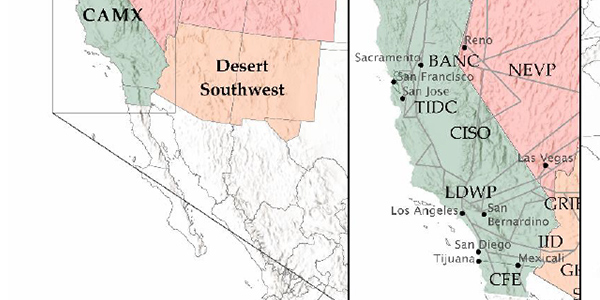The Western Interconnection’s California-Mexico (CAMX) subregion cannot maintain resource adequacy without imports, and the greatest risk of failing to meet load is in Southern California, WECC said last week.
“In 2021 and beyond, even with all planned resource additions, the CAMX subregion needs external assistance to maintain resource adequacy,” WECC said in a recent report and an online presentation last week. The summer-peaking CAMX subregion includes most of California and parts of Nevada and Baja California, Mexico.
Although imports “greatly reduce the probability of being resource inadequate, growing supply and demand variability across the interconnection increases the risk that imports may not be available when needed,” WECC said.
WECC said Southern California could experience two hours of unserved load this year and eight hours in 2022 under a one-day-in-ten-year (ODITY) threshold in a scenario that includes imports and resources currently under construction (Tier 1), or that have begun licensing, siting or permitting processes (Tier 2).
When analysts excluded Tier 2 resources, the number of hours Southern California would fail to meet the ODITY threshold increased to 10 in 2021 and 29 in 2024, WECC said.
If imports are excluded and only Tier 1 resources are available, the number of hours with potential demand at risk increases to 140 this year.
Unseasonal heat waves and Southern California’s dependence on capacity imported from other states make it especially vulnerable to blackouts like those it experienced last summer, the report said. Southern California Edison, which serves 15 million residents, has the largest percentage of demand and the widest variability in resource availability in the CAMX subregion, it said.
“The biggest problem … we’re facing is variability, and I think everyone’s aware of that,” Matt Elkins, WECC’s manager of performance and resource adequacy, said in the Feb. 16 webinar. “You really have to start looking at ‘What could the potential be?’”
Extreme heat waves in the West and frigid weather in Texas show traditional “expectations are off, and those are the kind of things we have to start planning for, especially with variable resources” such as wind and solar, Elkins said.
Northern California, mostly served by Pacific Gas and Electric, has a lower risk of resource inadequacy in the coming years and should be able to meet the ODITY threshold with imports and the addition of resources under construction or in the later planning stages, the report said.
In addition, changing weather and variable generation from renewable resources could mean a 15% reserve margin across all months is no longer adequate for CAMX, it said.
“In May and June, the months when variability in energy supply and demand is highest, a planning reserve margin near 40% may be needed,” to meet the 1-in-10 standard, the report said. “In fact, if a flat 15% planning reserve margin were applied to all hours of 2021, over 40% of the hours would not meet the [1 in 10] threshold.”
CAMX is expected to peak this year in late August at about 51,300 MW, with a 5% probability that the peak could hit 63,000 MW, a 25% load forecast uncertainty. The expected availability of resources on the peak hour is 57,800 MW, with a 5% chance of having only 44,400 MW available.
WECC’s latest subregional analysis followed its recent report on the Desert Southwest, which concluded that region is also at risk of failing to meet peak loads in 2021 and 2022 even under a best-case scenario. (See SW Faces RA Shortfall in 2021 and Beyond, WECC Says.)
The next and final subregional report on the vast Northwest Power Pool is expected Feb. 26 with a webinar scheduled on March 2.
The subregional reports build on WECC’s Western Assessment for Resource Adequacy, released in December, which found that the Western Interconnection could experience one to eight hours in which some of its subregions fail to meet load under the ODITY threshold. It recommended that Western utilities and state regulators increase coordination and adopt dynamic planning reserve margins to ensure the grid has adequate resources as it takes on more variable generation. (See Western RA Planning Must Change, WECC Says.)
Potential resource shortfalls have become a growing concern in California and other parts of the West as fossil fuel plants retire and renewable resources multiply. The issue took on new urgency in August and September 2020, when widespread heat waves prompted rolling blackouts in California and grid emergencies in neighboring regions.
Shortages occurred in the early evening as solar waned, not during the peak demand hour in the afternoon.
“That hour’s no longer the riskiest hour,” Elkins said. “It’s still the highest demand hour, but we’ve got to account for variability in other hours.”




